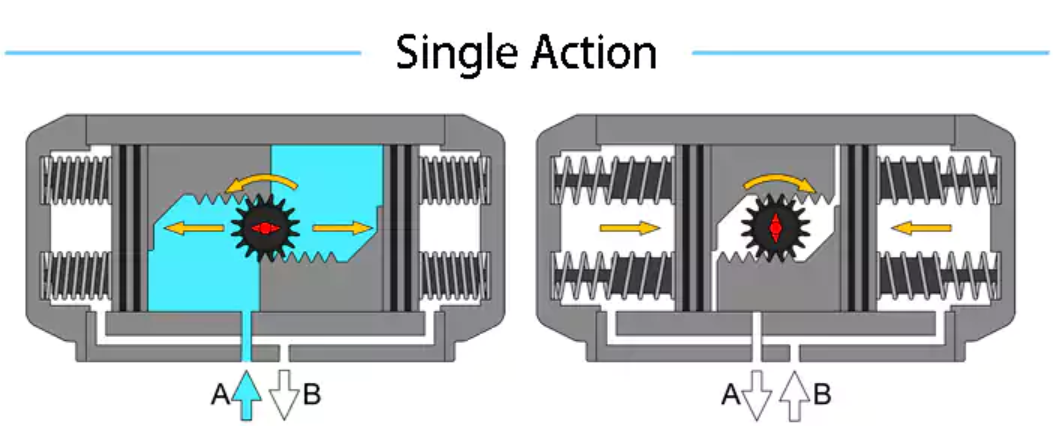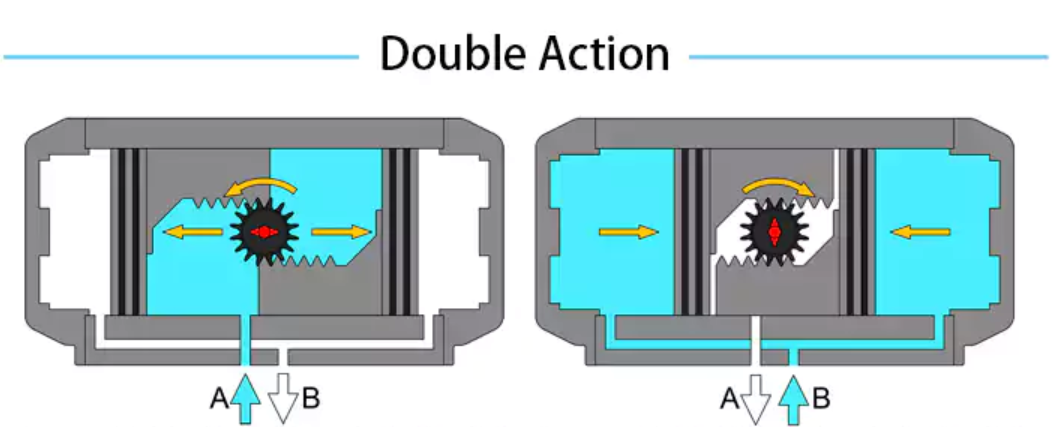Choose Single or Double Action Pneumatic Butterfly Control Valve?
On this page
A pneumatic butterfly control valve consists of two primary components: the pneumatic actuator and the butterfly valve itself. Butterfly valves are essential for controlling the flow of liquids and gases in various industrial and commercial applications. Their main characteristics include a simple structure, small size, lightweight design, and rapid opening and closing movements. This makes them a popular choice for piping systems where efficient fluid control is necessary.
A pneumatic butterfly control valve is a type of valve that combines a butterfly valve with a pneumatic actuator. The actuator uses compressed air to drive the opening and closing or regulate the valve. Compared to electric actuators, pneumatic actuators are known for their quick execution, often performing actions in as little as 0.05 seconds.
Pneumatic actuators are essential components in industrial automation, responsible for controlling mechanical devices like valves. They can be classified into two main types based on their supply method of compressed air or gas: single-acting and double-acting actuators. Understanding the differences between these two types is crucial for selecting the right actuator for specific applications.
Single-acting pneumatic actuators are further categorized into normally open and normally closed types.
 This type of actuator closes the valve when air is supplied and opens it when the air supply is cut off. The cylinder automatically resets to the initial closed state when the air source is lost.
In contrast, the normally closed type opens the valve when air is supplied and closes it when the air supply is cut off. The cylinder resets to the initial open state when the air source is lost.
Double-acting pneumatic actuators rely entirely on the air source for both opening and closing actions. When air is supplied, the cylinder opens; when the air supply is cut off, the cylinder remains in its last position, without resetting. This type of actuator does not have secondary classification, as its actions are solely driven by the air source.
This type of actuator closes the valve when air is supplied and opens it when the air supply is cut off. The cylinder automatically resets to the initial closed state when the air source is lost.
In contrast, the normally closed type opens the valve when air is supplied and closes it when the air supply is cut off. The cylinder resets to the initial open state when the air source is lost.
Double-acting pneumatic actuators rely entirely on the air source for both opening and closing actions. When air is supplied, the cylinder opens; when the air supply is cut off, the cylinder remains in its last position, without resetting. This type of actuator does not have secondary classification, as its actions are solely driven by the air source.
 The choice between single-acting and double-acting pneumatic actuators depends on several factors, including application requirements and operational conditions. Here are some key differences:
Single-acting actuators are generally more energy-efficient as they use air pressure for one direction only, relying on a spring for the return action. Double-acting actuators require continuous air supply for both directions, potentially increasing energy consumption.
Single-acting actuators have an inherent fail-safe feature, returning to a default position (open or closed) when the air supply is lost. This is particularly useful in applications where safety is critical. Double-acting actuators, however, remain in their last position when the air supply is cut off, which may not be suitable for all safety-critical applications.
Double-acting actuators typically provide higher force and faster response times compared to single-acting actuators, making them suitable for applications requiring rapid and robust actions.
Single-acting actuators have a simpler design with fewer components, potentially reducing installation and maintenance complexity. Double-acting actuators, while more complex, offer greater control precision.
When deciding between single-acting and double-acting pneumatic butterfly valves, consider the specific requirements of your application:
Single-acting actuators are preferable due to their fail-safe mechanism and lower energy consumption.
Double-acting actuators are ideal for applications demanding robust and rapid operations.
Single-acting actuators may be more suitable due to their simpler design.
Pneumatic butterfly control valves, whether equipped with single-acting or double-acting actuators, play a vital role in fluid control across various industries. Understanding the differences between these actuator types can help you make informed decisions, ensuring optimal performance and safety in your applications. Whether you prioritize energy efficiency, fail-safe features, force, speed, or ease of maintenance, there is a pneumatic butterfly control valve solution to meet your needs.
The choice between single-acting and double-acting pneumatic actuators depends on several factors, including application requirements and operational conditions. Here are some key differences:
Single-acting actuators are generally more energy-efficient as they use air pressure for one direction only, relying on a spring for the return action. Double-acting actuators require continuous air supply for both directions, potentially increasing energy consumption.
Single-acting actuators have an inherent fail-safe feature, returning to a default position (open or closed) when the air supply is lost. This is particularly useful in applications where safety is critical. Double-acting actuators, however, remain in their last position when the air supply is cut off, which may not be suitable for all safety-critical applications.
Double-acting actuators typically provide higher force and faster response times compared to single-acting actuators, making them suitable for applications requiring rapid and robust actions.
Single-acting actuators have a simpler design with fewer components, potentially reducing installation and maintenance complexity. Double-acting actuators, while more complex, offer greater control precision.
When deciding between single-acting and double-acting pneumatic butterfly valves, consider the specific requirements of your application:
Single-acting actuators are preferable due to their fail-safe mechanism and lower energy consumption.
Double-acting actuators are ideal for applications demanding robust and rapid operations.
Single-acting actuators may be more suitable due to their simpler design.
Pneumatic butterfly control valves, whether equipped with single-acting or double-acting actuators, play a vital role in fluid control across various industries. Understanding the differences between these actuator types can help you make informed decisions, ensuring optimal performance and safety in your applications. Whether you prioritize energy efficiency, fail-safe features, force, speed, or ease of maintenance, there is a pneumatic butterfly control valve solution to meet your needs.
 This type of actuator closes the valve when air is supplied and opens it when the air supply is cut off. The cylinder automatically resets to the initial closed state when the air source is lost.
In contrast, the normally closed type opens the valve when air is supplied and closes it when the air supply is cut off. The cylinder resets to the initial open state when the air source is lost.
Double-acting pneumatic actuators rely entirely on the air source for both opening and closing actions. When air is supplied, the cylinder opens; when the air supply is cut off, the cylinder remains in its last position, without resetting. This type of actuator does not have secondary classification, as its actions are solely driven by the air source.
This type of actuator closes the valve when air is supplied and opens it when the air supply is cut off. The cylinder automatically resets to the initial closed state when the air source is lost.
In contrast, the normally closed type opens the valve when air is supplied and closes it when the air supply is cut off. The cylinder resets to the initial open state when the air source is lost.
Double-acting pneumatic actuators rely entirely on the air source for both opening and closing actions. When air is supplied, the cylinder opens; when the air supply is cut off, the cylinder remains in its last position, without resetting. This type of actuator does not have secondary classification, as its actions are solely driven by the air source. The choice between single-acting and double-acting pneumatic actuators depends on several factors, including application requirements and operational conditions. Here are some key differences:
Single-acting actuators are generally more energy-efficient as they use air pressure for one direction only, relying on a spring for the return action. Double-acting actuators require continuous air supply for both directions, potentially increasing energy consumption.
Single-acting actuators have an inherent fail-safe feature, returning to a default position (open or closed) when the air supply is lost. This is particularly useful in applications where safety is critical. Double-acting actuators, however, remain in their last position when the air supply is cut off, which may not be suitable for all safety-critical applications.
Double-acting actuators typically provide higher force and faster response times compared to single-acting actuators, making them suitable for applications requiring rapid and robust actions.
Single-acting actuators have a simpler design with fewer components, potentially reducing installation and maintenance complexity. Double-acting actuators, while more complex, offer greater control precision.
When deciding between single-acting and double-acting pneumatic butterfly valves, consider the specific requirements of your application:
Single-acting actuators are preferable due to their fail-safe mechanism and lower energy consumption.
Double-acting actuators are ideal for applications demanding robust and rapid operations.
Single-acting actuators may be more suitable due to their simpler design.
Pneumatic butterfly control valves, whether equipped with single-acting or double-acting actuators, play a vital role in fluid control across various industries. Understanding the differences between these actuator types can help you make informed decisions, ensuring optimal performance and safety in your applications. Whether you prioritize energy efficiency, fail-safe features, force, speed, or ease of maintenance, there is a pneumatic butterfly control valve solution to meet your needs.
The choice between single-acting and double-acting pneumatic actuators depends on several factors, including application requirements and operational conditions. Here are some key differences:
Single-acting actuators are generally more energy-efficient as they use air pressure for one direction only, relying on a spring for the return action. Double-acting actuators require continuous air supply for both directions, potentially increasing energy consumption.
Single-acting actuators have an inherent fail-safe feature, returning to a default position (open or closed) when the air supply is lost. This is particularly useful in applications where safety is critical. Double-acting actuators, however, remain in their last position when the air supply is cut off, which may not be suitable for all safety-critical applications.
Double-acting actuators typically provide higher force and faster response times compared to single-acting actuators, making them suitable for applications requiring rapid and robust actions.
Single-acting actuators have a simpler design with fewer components, potentially reducing installation and maintenance complexity. Double-acting actuators, while more complex, offer greater control precision.
When deciding between single-acting and double-acting pneumatic butterfly valves, consider the specific requirements of your application:
Single-acting actuators are preferable due to their fail-safe mechanism and lower energy consumption.
Double-acting actuators are ideal for applications demanding robust and rapid operations.
Single-acting actuators may be more suitable due to their simpler design.
Pneumatic butterfly control valves, whether equipped with single-acting or double-acting actuators, play a vital role in fluid control across various industries. Understanding the differences between these actuator types can help you make informed decisions, ensuring optimal performance and safety in your applications. Whether you prioritize energy efficiency, fail-safe features, force, speed, or ease of maintenance, there is a pneumatic butterfly control valve solution to meet your needs.
